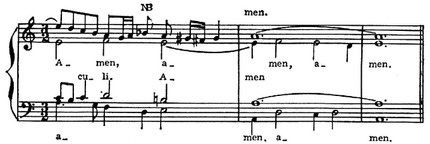
Neapolitan sixth chord |
English the neapolitan sixth, нем. Neapolitan sixth chord, Neapolitan sixth, чеш. neapolsky sextakord, frygicky sextakord
Second low sixth chord (or minor subdominant with a small sixth instead of a fifth). The term “N. With.” is associated with the characteristic use of this chord among the composers of the Neapolitan opera school con. 17th century (in particular, with A. Scarlatti, for example, in the opera Rosaura). However, the term is conditional, since H. s. appeared long before the Neapolitan school (by J. Obrecht, 2nd half of the 15th century).

Я. He slipped away. Mass “Salva diva parens”, Credo, Confiteor, takty 34-36.
It is widely used by composers of various countries and peoples (for example, by L. Beethoven). The author of the term “N. s”, perhaps, is L. Busler (1868), although there is evidence (X. Riemann) about its long-standing use of English. theorists (in English terminology there are three more “sexts”: “Italian” – a chord like as-c-fis, “French” – as-cd-fis and “German” – as-c-es-fis). In the sound system of the major-minor harmonic. tonality, all steps of which are covered by a chain of 11 fifths (from the central tonic. fifths – 5 down and 5 up), the characteristic sound of N. with. – II low degree – is achieved by the greatest deepening towards the flats (and therefore it is mirror-opposite to another important non-diatonic sound – the “Lydian” high IV degree; see Inclination.) Hence the thickened-gloomy shade characteristic of the modal (Phrygian) coloring of N. s. (an even darker color is inherent in the minor version of N. with, for example, fes-as-des in C-dur or c-moll). Functionally N. with. – the “extreme” subdominant, the limit of movement in this direction (which makes it possible to use the N. s. as a critical point of harmonious development; see, for example, the culmination of the c-moll passacaglia for J. S. Bach’s organ).

J. S. Bach. Passacaglia in c-moll for organ.
Within the framework of the 7-step diatonic or 10-step major-minor system, for example, with the tonic C – systems:

the sound of the II low level, which turned out to be outside the main. steps, should have been explained as alteration, non-diatonic auxiliary as borrowing from the scale of another key (minor subdominant) or from another mode (Phrygian) with the same tonic (see literature review in the book by V. O. Berkov). Mn. researchers fairly interpreted N. of page. how they are independent. harmony, and not as a chromatically modified (altered) chord (O. Savard, R. Louis, L. Thuil, etc.). According to the observation of V. O. Berkov, in the music. there are almost no examples of N.’s education in practice. alternative way. The most correct interpretation of N. s. as a non-altered harmony belonging to the twelve-sound modal system (“chromatic”, according to G. L. Catuar; “twelve-sound diatonic”, according to A. S. Ogolevets). In addition to N. s, “Neapolitan” harmony (Czech frygicke akord)

L. Beethoven. 3rd symphony, movement I.
is used as a triad (L. Beethoven, sonata op. 57, part 1, vols. 5-6), quarter-sext chord (F. Liszt, 1st concerto, vol. 4), seventh chord (also in circulation) and even a separate sound.

L. Beethoven. Concerto for violin and orchestra, part I.
References: Rimsky-Korsakov N., Practical textbook of harmony, St. Petersburg, 1886, the same, Poly. coll. soch., vol. IV, M., 1960; Catuar G., Theoretical course of harmony, part 1, M., 1924; Ogolevets A. S., Introduction to modern musical thinking, M. – L., 1946; Berkov V., Harmony and musical form, M., 1962, under the title: Formative means of harmony, M., 1971; Riemann H., Vereinfachte Harmonielehre oder die Lehre von den tonalen Funktionen der Akkorde, NY – L., 1893 Reger M., Beiträge zur Modulationslehre, Münch., 1896, 1901 (in Russian translation – O modulation, L., 1903); Schenker H., Neue musikalische Theorien und Phantasien, Bd 1922, B. – Stuttg., 1926, W., 1; Handke R., Der neapolitanische Sextakkord in Bachscher Auffassung, in Bach-Jahrbuch, Jahrg. 1906, Lpz., 1956; Montnacher J., Das Problem des Akkordes der neapolitanischen Sexte…, Lpz., 16; Piston W., Harmony, NY, 1920; Stephani H., Stadien harmonischer Sinnerfüllung, “Musikforschung”, 1934, Jahrg. 1941, H. 1956; Janecek K., Harmonie rozborem, Praha, 9.
Yu. H. Kholopov



